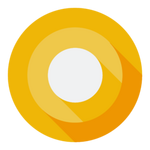Android Oreo (codenamed Android O during development) is the eighth major release and the 15th version of the Android operating system. First released as an alpha quality developer preview in March 2017, it was publicly released on August 21, 2017.
About Android O[]
On March 21, 2017, Google released the first developer preview of Android "O",available for the Nexus 5X, Nexus 6P, Nexus Player, Pixel C, and Pixel smartphone devices. Google will release a total of four developer previews; the second, now considered beta quality, was released May 17, 2017,followed by further previews in June and July. A final, official release is scheduled for the third quarter of 2017.
Features of Android O[]
Notifications can be snoozed, and batched into topic-based groups known as "channels".Android "O" contains integrated support for picture-in-picturemodes. Adding a custom ringtone, alarm or notification sound is simplified. The "Settings" app features a new design, with a white theme and deeper categorization of different settings. Android TV features a new launcher.
Platform Support[]
Android "O" will add support for Neighborhood Aware Networking (NAN) for Wi-Fibased on Wi-Fi Aware,wide color gamuts in apps,an API for autofillers, multiprocess and Google Safe Browsing support for WebViews, an API to allow system-level integration for VoIP apps, and launching activities on remote displays.Android Runtime (ART) features performance improvements.Android "O" contains additional limits on apps' background activities in order to improve battery life. Apps can specify "adaptive icons" for differently-shaped containers specified by themes, such as circles, squares, and squircles.
Android "O" supports new emoji that will be included in the Unicode 10 standard. A new emoji font was also introduced, which notably redesigns its face figures to use a traditional circular shape, as opposed to the "blob" design that was introduced on Android "KitKat".
The underlying architecture of Android is being revised so that low-level, vendor-specific code for supporting a device's hardware will be separated from the Android OS framework using a hardware abstraction layer known as the "vendor interface". Vendor interfaces will be required to be forward compatible with future versions of Android; due to these changes, OEMs will only need to perform their necessary modifications to the OS framework and bundled apps to update a device to a future version of Android, while maintaining the same vendor interface.
The operating system will offer a tailored distribution for low-end devices known as Android Go, which will be used on all devices with 1 GB of RAM or less. These devices will ship with platform optimizations designed to reduce mobile data usage (including enabling Data Saver mode by default), and a special suite ofGoogle Mobile Services designed to be less resource- and bandwidth-intensive (such as YouTube Go). Google Play Store will also highlight lightweight apps suited for these devices.
Android Oreo is released[]
Google unveiled the Developer Preview of Android O in March 2017, ahead of its May Google I/O Developer's Conference. Since then we've had various public betas, and today - 21 August 2017 - Google has announced the final version.
Google will begin rolling out the OTA update to Pixel and Nexus devices soon, but right now is pushing Oreo only to Android Open Source Project (AOSP) for other manufacturers to begin working on their own updates. Those on the public beta will also be updated to the final version from today.
Google states: "We're pushing the sources to Android Open Source Project (AOSP) for everyone to access today. Pixel and Nexus 5X/6P builds have entered carrier testing, and we expect to start rolling out in phases soon, alongside Pixel C and Nexus Player.
"We’ve also been working closely with our partners, and by the end of this year, hardware makers including Essential, General Mobile, HMD Global Home of Nokia Phones, Huawei, HTC, Kyocera, LG, Motorola, Samsung, Sharp and Sony are scheduled to launch or upgrade devices to Android 8.0 Oreo.
"Any devices enrolled in the Android Beta Program will also receive this final version."
We'll update this article when the final version begins rolling out to Google devices OTA. In the meantime, you can install Android Oreo via the public beta if you have a compatible device.


